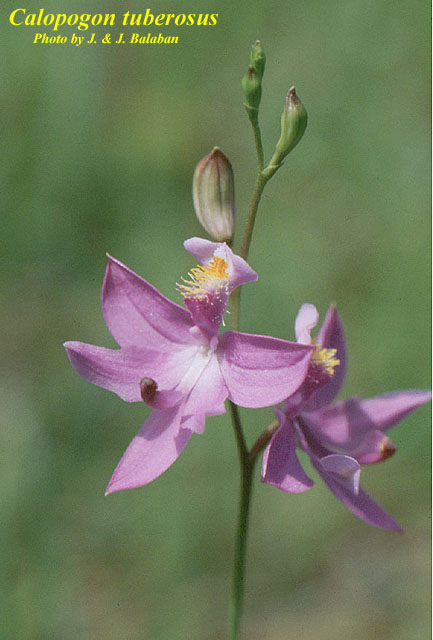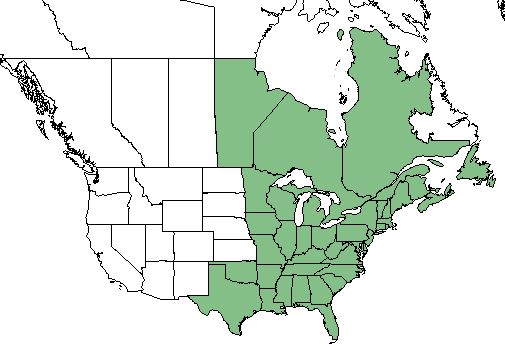Calopogon tuberosus
Common Names: tuberosus grasspink [1], Grass Pink Orchid [2]
| Calopogon tuberosus | |
|---|---|

| |
| Photo by the Atlas of Florida Plants Database | |
| Scientific classification | |
| Kingdom: | Plantae |
| Division: | Magnoliophyta - Flowering plants |
| Class: | Liliopsida - Moncots |
| Order: | Orchidales |
| Family: | Orchidaceae |
| Genus: | Calopogon |
| Species: | C. tuberosus |
| Binomial name | |
| Calopogon tuberosus L | |

| |
| Natural range of Calopogon tuberosus from USDA NRCS Plants Database. | |
Contents
Taxonomic Notes
Synonyms: C. pulchellus (R. Brown), Limodorum tuberosum (Linnaeus)
Varieties: none
Description
C. tuberosus is a perennial forb/herb in the Orchidaceae family native to North America. [1]
Distribution
Found along the east coast of the United States and Canada into the center of North America, the C. tuberosus is common in savannas, sandhill seeps, and in bogs within mountain regions. [3]
Ecology
Habitat
C. tuberosus is common in savannas, sandhill seeps, floating peat mats, and other regions during April to September. [3]
A variety of habitats that this orchid can been found include, marl prairies, pine flatwoods, roadsides, fens, and bogs. [4]
Specimens of C. tuberosus have been collected from moist loamy sand of savanna like longleaf pine regions, and wet seepage areas. [5]
Seed bank and germination
Generally, warmer temperatures produce more seedling germination for the C. tuberosus with the exception of Michigan where cooler temperatures resulted in more germination. Also, fluctuating temperatures are more beneficial than stagnant temperatures. [6]
Pollination
C. tuberosus does not provide a benefit to pollinators, due to this aspect they use deceit to get pollinators to come. Bees land on fake stamens which causes the structure to collapse and transfer pollen to the bee. .[7]
Conservation and Management
In 2015, the C. tuberosus was considered endangered in the Illinois region. [8]
Cultivation and restoration
Photo Gallery
References and notes
- ↑ 1.0 1.1 USDA Plant Database Cite error: Invalid
<ref>tag; name "USDA" defined multiple times with different content - ↑ Board, I. E. S. P. (2015). "CHECKLIST OF ILLINOIS ENDANGERED AND THREATENED ANIMALS AND PLANTS." Illinois List of Endangered and Threatened Species: 1-16.
- ↑ 3.0 3.1 [Weakley, A. S. (2015). Flora of the Southern and Mid-Atlantic States. Chapel Hill, NC, University of North Carolina Herbarium.]
- ↑ Kauth, P. J., et al. (2011). "Comparative in vitro germination ecology of Calopogon tuberosus var. tuberosus (Orchidaceae) across its geographic range." The Society for In Vitro Biology: 148-156.
- ↑ URL: http://herbarium.bio.fsu.edu. Last accessed: June 2018. Collectors: Loran C. Anderson, R.A. Norris, Rodie White, R.K. Godfrey, R. Komarek. States and counties: Florida (Wakulla, Taylor, Liberty, Leon, Jackson) Georgia (Grady, Thomas)
- ↑ [Kauth, P. J., et al. (2011). "Comparative in vitro germination ecology of Calopogon tuberosus var. tuberosus (Orchidaceae) across its geographic range." The Society for In Vitro Biology: 148-156.]
- ↑ Explained by Roger Hammer, May 2018, posted to Florida Flora and Ecosystematics Facebook Group May 20, 2018.
- ↑ [Board, I. E. S. P. (2015). "CHECKLIST OF ILLINOIS ENDANGERED AND THREATENED ANIMALS AND PLANTS." Illinois List of Endangered and Threatened Species: 1-16.]